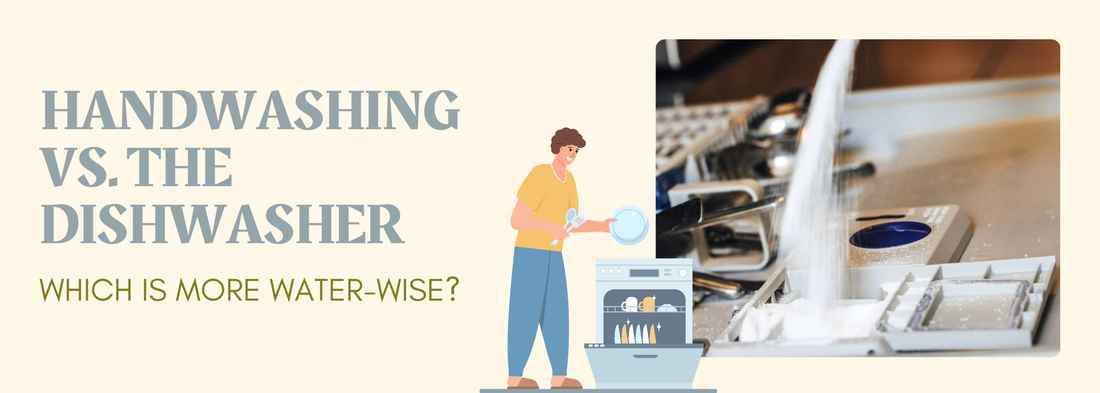
What’s the Most Water-Wise Way to do Dishes: By Hand or Machine?
Share
We get asked this a lot: “Is it better to wash dishes by hand or use the dishwasher if I’m trying to be eco-friendly?”
It’s a fair question. Dishes are part of daily life, and if you’re trying to save water, waste less, or lower your utility bill, the kitchen sink is a great place to start. At Vessel, we’re all about practical sustainability that fits real life. And we all know that real life contains a whole lot of dishes. But do they have to pile up every day?? Ugh, anyway…
Here’s what science (and experience) says about the most water-efficient way to tackle your dishes – plus some low-waste tips to make whichever method you use even better.
Let’s talk numbers: Dishwasher vs. Handwashing
If you grew up hearing that dishwashers waste water, you’re not alone. But modern machines? They’re surprisingly efficient. According to the EPA’s Energy Star program, an Energy Star-rated dishwasher uses about 3–5 gallons of water per load, compared to 20+ gallons for a full sink of hand-washing… especially if you’re leaving the tap running while scrubbing up.
In fact, studies show that using a dishwasher can cut water usage by up to 80%, especially if you are running full loads only.
Of course, not everyone has a dishwasher, and not all dishwashers are created equal. Older models can use closer to 10-15 gallons per load. So if you're working with vintage kitchen tech or a shared space, it's still worth knowing how to hand-wash more efficiently.
How to be more water-wise when hand washing
If you don’t have a dishwasher or prefer washing by hand, good news: you can do it without wasting a ton of water, it just takes a little intention!
The least efficient way to hand wash? Leaving the water running the whole time while you scrub, rinse, and contemplate your life choices. And hey, who hasn’t spaced out while staring into the abyss of the deep, soapy sink? Amirite? Heh heh.. Just me? Okay, but let’s lock back in and try this two-step method instead:
-
Fill one side of your sink or a basin with warm, soapy water and let the dishes soak and get scrubbed there.
-
Use a separate bowl or basin of clean water for rinsing, or briefly turn the tap on to rinse a few items at once.
If you don’t have a two-basin sink, don’t fret! Simply scrub all the dishes, leave them soapy, and then rinse them all at once before stacking them in the drying rack. This saves time too since you won’t be pausing to switch between washing and rinsing.
Also, skip the pre-rinse unless something’s really crusty. Most of the time, a quick scrape is all you need before you wash, and it saves gallons.
Tools that make it easier, less wasteful, and way more fun
Whether you're a hand-washer, a machine-user, or somewhere in between, the tools you use can make a huge difference in both water usage and waste. At Vessel, we stock sustainable dish-cleaning essentials that help you clean smarter, not harder.
Some of our favorites include:
- Swedish Dishcloths: Absorbent, quick-drying, and totally compostable. Use them in place of sponges or paper towels—they last for months and never get that funky sponge smell.
- UnPaper Towels: Perfect for drying dishes or wiping down the counter after you inevitably spill while trying to multitask.
- Refillable Dish Soap: Skip the plastic bottle and refill what you’ve already got with gentle, effective formulas that are easy on your hands and the planet. reuse the same container over and over, no single-use bottles needed!
- Wooden Dish Brushes & Natural Scrubbers: Durable, biodegradable, and actually cute on your sink ledge. No plastic handles, no waste.
-
Solid Dish Soap Block: Made with essential oils and plastic-free packaging, this multi-purpose, super-concentrated dish block is the cleaning powerhouse your kitchen needs.
By using reusable, compostable, or refillable tools, you’re not only reducing plastic waste, you’re also choosing materials that don’t shed microplastics into the water stream while you clean. I’m looking at you, ScrubDaddy…
So which is better: dishwasher or hand washing?
The short answer?
If you have a newer, Energy Star-rated dishwasher and run it only when full, the dishwasher wins! Both in terms of water efficiency and energy use.
But if you’re washing by hand using a basin or two-bucket method, you can still do it in a water-wise way that’s just as eco-friendly (especially if your dishwasher is older or non-existent).
It’s less about the method, and more about how you do it.
At-a-glance: How to wash dishes more sustainably
No matter how you wash, these tips will help reduce your water usage, plastic waste, and general dish-related dread:
- Only run the dishwasher when it’s fully loaded
- Skip the pre-rinse, just scrape the plate (bonus points if you’re composting the food waste!)
- Use cold water when possible (for rinsing or soaking)
- Use natural brushes, reusable cloths, and long-lasting tools
- Refill your dish soap to cut down on plastic
- Try setting a “dish timer” if you hand wash. Limit your soak-and-rinse sessions to avoid zoning out and running water forever
- Let dishes air dry instead of using a towel or the heated dry cycle
TL;DR – It’s less about the method, more about the mindset
Whether you hand wash or use a dishwasher, you can clean your dishes while saving some water for the fishes. A few thoughtful shifts in how you wash, what tools you use, and how often you run your dishwasher can save gallons of water every week.
And if you're ready to make your sink set-up a little greener? Swing by Vessel Refills in Escondido. We’ve got refillable soaps, scrubby cloths, natural brushes, and sustainable swaps that’ll make dish duty a little less dreadful and a whole lot more low-waste.